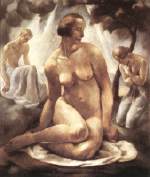

Besides avant-garde, neo-classicist trends became stronger during the early 1920s. Pictures of a young generation (Erzsébet Korb, Károly Patkó, István Szőnyi) after World War I showed monumental nudes in peace, or heroic self-portraits and monumental landscapes. Their drawings and some other pictures reflect the influence of expressionism and cubism definitely, e.g. drawings of Vilmos Aba-Novák where figures are cut into pieces by geometric lines of light (Light).
In addition to nudes, self-portraits are particularly stressed, and "role-playing" portrayals are highly characteristic (Szőnyi: At the Peak). Landscapes are related to particular parts of the country: Aba-Novák and Patkó, accompanied by some others, used to work in Felsőbánya not far from Nagybánya in 1925, then in Igal in 1927. Szőnyi settled down in Zebegény by the Danube in 1924, from that year onwards his pictures showed more and more everyday events of country life.
Representatives of the style developed in the next stage of their careers in different directions: Aba-Novák and Patkó were the first to join the Roman school, and Szőnyi the Gresham Group (post-Nagybánya painting).
Many other young artists started their careers in neo-classicism. The motif of Arcadia or biblical themes are often present in early pictures of Gyula Derkovits (Last Supper), or in pastels of Dávid Jándi in expressive colours (View of Florence) or compositions of Jenő Paizs Goebel (St.Sebestian).